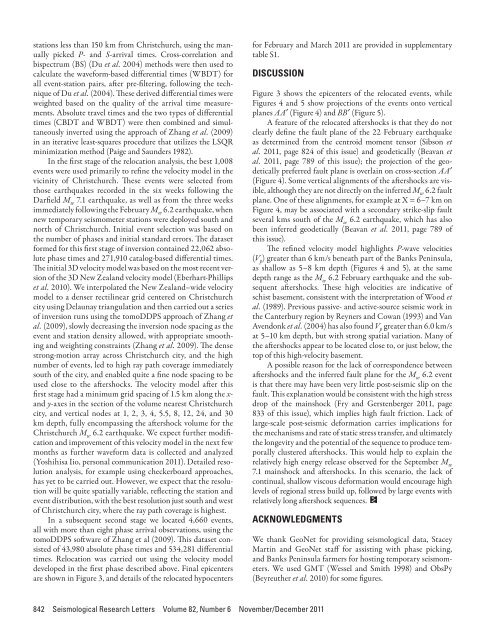Here - Stuff
Here - Stuff
Here - Stuff
Create successful ePaper yourself
Turn your PDF publications into a flip-book with our unique Google optimized e-Paper software.
stations less than 150 km from Christchurch, using the manuallypicked P- and S-arrival times. Cross-correlation andbispectrum (BS) (Du et al. 2004) methods were then used tocalculate the waveform-based differential times (WBDT) forall event-station pairs, after pre-filtering, following the techniqueof Du et al. (2004). These derived differential times wereweighted based on the quality of the arrival time measurements.Absolute travel times and the two types of differentialtimes (CBDT and WBDT) were then combined and simultaneouslyinverted using the approach of Zhang et al. (2009)in an iterative least-squares procedure that utilizes the LSQRminimization method (Paige and Saunders 1982).In the first stage of the relocation analysis, the best 1,008events were used primarily to refine the velocity model in thevicinity of Christchurch. These events were selected fromthose earthquakes recorded in the six weeks following theDarfield M w 7.1 earthquake, as well as from the three weeksimmediately following the February M w 6.2 earthquake, whennew temporary seismometer stations were deployed south andnorth of Christchurch. Initial event selection was based onthe number of phases and initial standard errors. The datasetformed for this first stage of inversion contained 22,062 absolutephase times and 271,910 catalog-based differential times.The initial 3D velocity model was based on the most recent versionof the 3D New Zealand velocity model (Eberhart-Phillipset al. 2010). We interpolated the New Zealand–wide velocitymodel to a denser rectilinear grid centered on Christchurchcity using Delaunay triangulation and then carried out a seriesof inversion runs using the tomoDDPS approach of Zhang etal. (2009), slowly decreasing the inversion node spacing as theevent and station density allowed, with appropriate smoothingand weighting constraints (Zhang et al. 2009). The densestrong-motion array across Christchurch city, and the highnumber of events, led to high ray path coverage immediatelysouth of the city, and enabled quite a fine node spacing to beused close to the aftershocks. The velocity model after thisfirst stage had a minimum grid spacing of 1.5 km along the x-and y-axes in the section of the volume nearest Christchurchcity, and vertical nodes at 1, 2, 3, 4, 5.5, 8, 12, 24, and 30km depth, fully encompassing the aftershock volume for theChristchurch M w 6.2 earthquake. We expect further modificationand improvement of this velocity model in the next fewmonths as further waveform data is collected and analyzed(Yoshihisa Iio, personal communication 2011). Detailed resolutionanalysis, for example using checkerboard approaches,has yet to be carried out. However, we expect that the resolutionwill be quite spatially variable, reflecting the station andevent distribution, with the best resolution just south and westof Christchurch city, where the ray path coverage is highest.In a subsequent second stage we located 4,660 events,all with more than eight phase arrival observations, using thetomoDDPS software of Zhang et al (2009). This dataset consistedof 43,980 absolute phase times and 534,281 differentialtimes. Relocation was carried out using the velocity modeldeveloped in the first phase described above. Final epicentersare shown in Figure 3, and details of the relocated hypocentersfor February and March 2011 are provided in supplementarytable S1.DISCUSSIONFigure 3 shows the epicenters of the relocated events, whileFigures 4 and 5 show projections of the events onto verticalplanes AA′ (Figure 4) and BB′ (Figure 5).A feature of the relocated aftershocks is that they do notclearly define the fault plane of the 22 February earthquakeas determined from the centroid moment tensor (Sibson etal. 2011, page 824 of this issue) and geodetically (Beavan etal. 2011, page 789 of this issue); the projection of the geodeticallypreferred fault plane is overlain on cross-section AA′(Figure 4). Some vertical alignments of the aftershocks are visible,although they are not directly on the inferred M w 6.2 faultplane. One of these alignments, for example at X = 6–7 km onFigure 4, may be associated with a secondary strike-slip faultseveral kms south of the M w 6.2 earthquake, which has alsobeen inferred geodetically (Beavan et al. 2011, page 789 ofthis issue).The refined velocity model highlights P-wave velocities(V p ) greater than 6 km/s beneath part of the Banks Peninsula,as shallow as 5–8 km depth (Figures 4 and 5), at the samedepth range as the M w 6.2 February earthquake and the subsequentaftershocks. These high velocities are indicative ofschist basement, consistent with the interpretation of Wood etal. (1989). Previous passive- and active-source seismic work inthe Canterbury region by Reyners and Cowan (1993) and VanAvendonk et al. (2004) has also found V p greater than 6.0 km/sat 5–10 km depth, but with strong spatial variation. Many ofthe aftershocks appear to be located close to, or just below, thetop of this high-velocity basement.A possible reason for the lack of correspondence betweenaftershocks and the inferred fault plane for the M w 6.2 eventis that there may have been very little post-seismic slip on thefault. This explanation would be consistent with the high stressdrop of the mainshock (Fry and Gerstenberger 2011, page833 of this issue), which implies high fault friction. Lack oflarge-scale post-seismic deformation carries implications forthe mechanisms and rate of static stress transfer, and ultimatelythe longevity and the potential of the sequence to produce temporallyclustered aftershocks. This would help to explain therelatively high energy release observed for the September M w7.1 mainshock and aftershocks. In this scenario, the lack ofcontinual, shallow viscous deformation would encourage highlevels of regional stress build up, followed by large events withrelatively long aftershock sequences.ACKNOWLEDGMENTSWe thank GeoNet for providing seismological data, StaceyMartin and GeoNet staff for assisting with phase picking,and Banks Peninsula farmers for hosting temporary seismometers.We used GMT (Wessel and Smith 1998) and ObsPy(Beyreuther et al. 2010) for some figures.842 Seismological Research Letters Volume 82, Number 6 November/December 2011
















